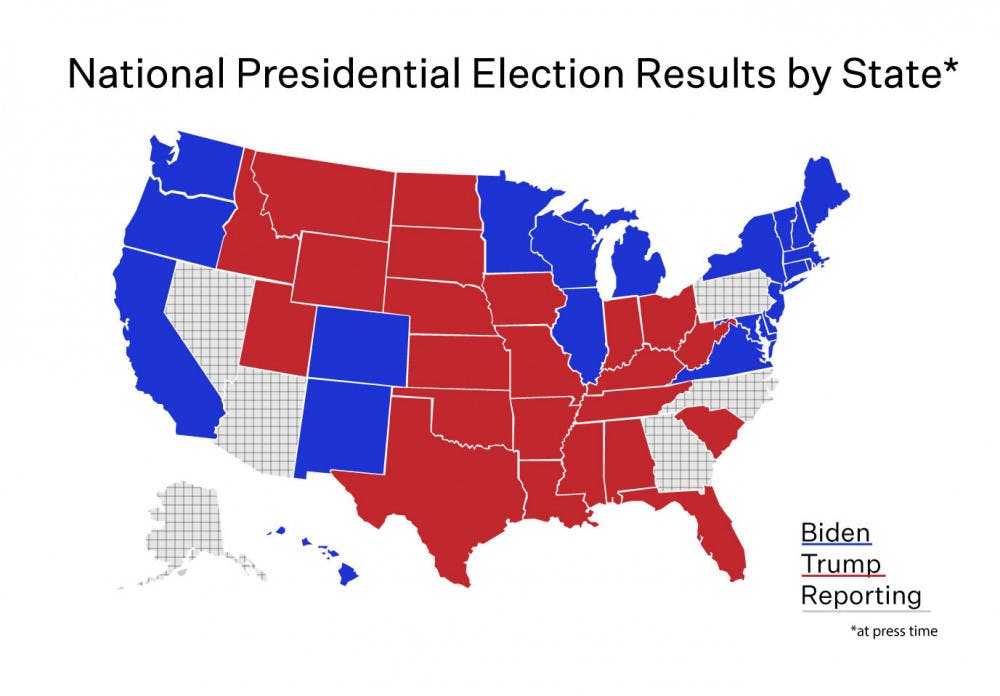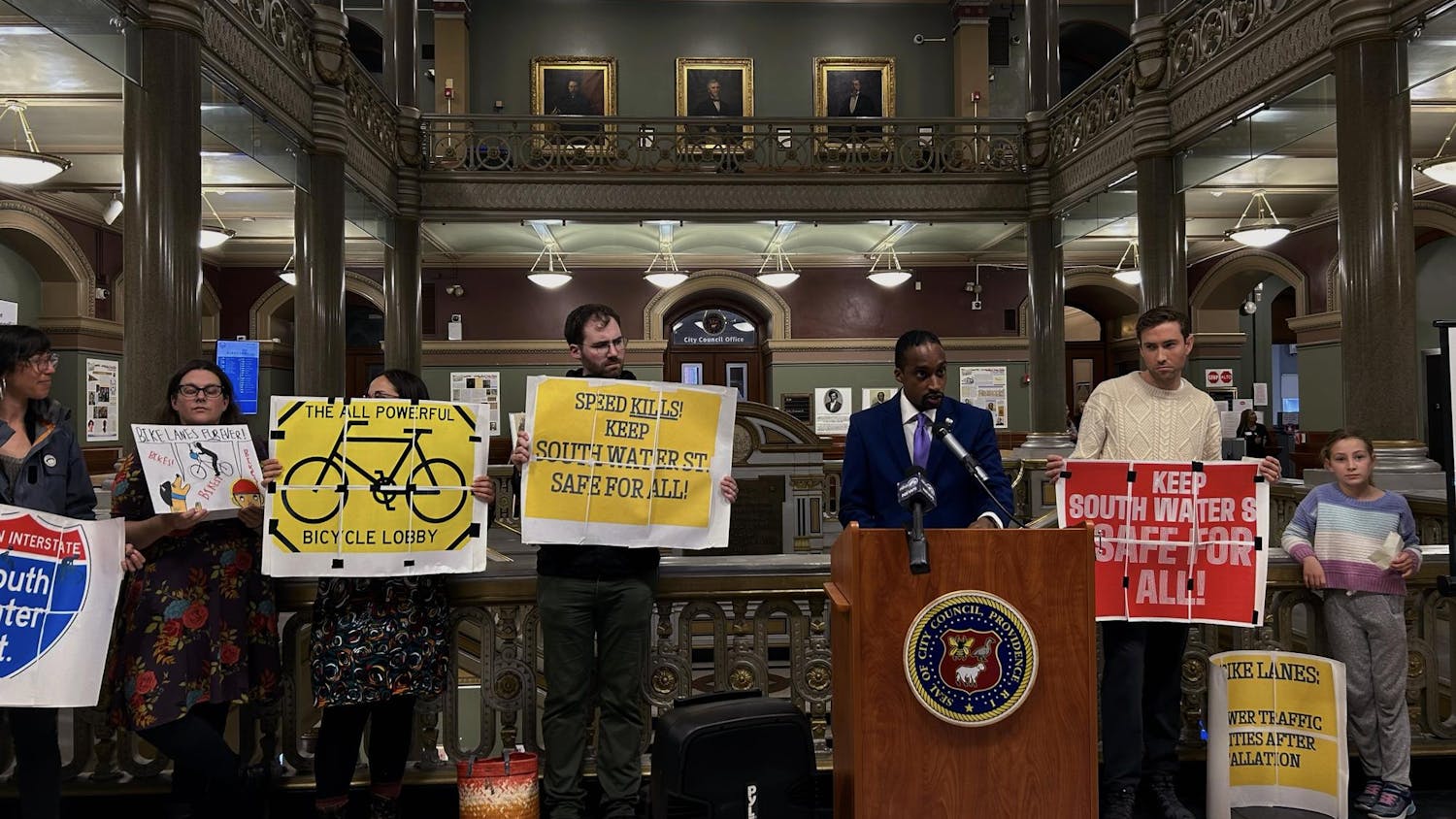Over two days after the first polls closed on Election Day, no winner has been declared in the race for U.S. president.
Former Vice President Joe Biden moved closer to an electoral college victory early Nov. 6, almost entirely eliminating his vote deficits in Georgia and Pennsylvania, as election workers continue to count mail-in ballots across the country. But, the close margins in some key state races kept incumbent President Donald Trump’s hopes of reelection alive.
As of early Friday morning, Biden had secured 253 electoral votes to Trump’s 214, according to the New York Times. Either candidate must secure at least 270 electoral votes to claim victory. Six states remain uncalled: Nevada, Arizona, Pennsylvania, North Carolina, Georgia and Alaska.
As it currently stands, Biden has more paths to victory in the electoral college than Trump — winning any two of the states would put the former vice president over the line. And if Biden clinches Pennsylvania alone — the largest of the remaining states with 20 electoral votes — he’ll win his presidential bid.
Arizona, along with its 11 electoral votes, was called on Election Night by the Associated Press and Fox News, but remained uncalled by CBS, ABC, NBC and The New York Times, among others, at press time.
Even as the outcome in the electoral college hung in the balance, Biden took a decisive lead in the popular vote. Over 73 million ballots were counted for the Democratic nominee as of early Nov. 6 — breaking President Barack Obama’s 2008 record for the most votes ever cast in a presidential election for one candidate. At press time, Trump trailed Biden by about four million votes.
Brown students have waited anxiously for results to come in.
In past elections, University students — overwhelmingly liberal, according to Herald data — have gathered to celebrate the election of Democrats or lament the success of Republicans. In 2016 after the election of Trump, many students took to the streets in tears, The Herald previously reported. Eight years prior, the Main Green was a celebration spot for many University students who were excited to elect the country’s first Black president.
This year, the University has strongly discouraged in-person gatherings, citing COVID-19 restrictions. Instead, the University has advertised digital debriefs and events.
Unprecedented levels of voting by mail have delayed results of the 2020 election. Many states, including Rhode Island, made voting by mail easier for their residents, driving record turnout amid a pandemic that has killed over 235,000 Americans.
Democrats were more likely to vote by mail than Republicans, so as mail-in ballots were slowly counted, Biden gained in key states like Georgia and Pennsylvania. Some states, including Michigan and Wisconsin, where Trump appeared to be leading at the end of Election Night eventually flipped for Biden.
But despite Biden’s narrow lead, several states remain inconclusive early Nov. 6. Trump has held on to a close advantage in Pennsylvania and Georgia since Election Night, but the remaining mail-in ballots to be counted could shift the states blue.
Trump has criticized the heavy influx of mail-in ballots in battleground states like Pennsylvania, Arizona, Michigan and Wisconsin. On Nov. 5, the Trump campaign began pursuing legal action to stop the counting of mail-in votes in Pennsylvania, already bringing the case up to the Supreme Court. The Trump campaign also called for a recount of Wisconsin votes. The president additionally “claimed” the state of Michigan in a tweet Nov. 4, despite the Associated Press calling the state for Biden.
“If you count the legal votes, I easily win,” Trump said in a press conference Nov. 5. “If you count the illegal votes, they can try to steal the election from us — if you count the votes that came in late.”
Trump also questioned the prevalence of blue mail-in votes, noting a lack of Republican mail-in ballots could be a sign of “fraud” in this election. Over the past few months, Trump discouraged voters from using mail-in ballots in the months leading up to November.
Early on Election Night, Florida, a swing state, was called for Trump. The Sunshine State’s 29 electoral college votes were essential for Trump’s hopes of reelection, and the incumbent was victorious following significant gains with Hispanic voters in Miami-Dade County, typically a Democratic stronghold.
Polls in Florida leading up to Nov. 3 showed Biden with a slight advantage — 2 points on average, according to FiveThirtyEight — which Trump greatly overperformed in the final tally, winning by 3.4 points with 96 percent of the vote reported.
Traditionally Republican-dominated states such as Iowa, Ohio and Texas that Biden had hoped to flip — which were essentially toss-ups in polling averages — were called for Trump on Tuesday, squashing Democratic hopes of a landslide victory for the former Vice President.
Upper midwestern states Wisconsin and Michigan, with 10 and 16 electoral votes, respectively, were the first states to flip from choosing Trump in 2016 to Biden in 2020. While the two states appeared to favor Trump throughout Election Night, both were called for Biden on Nov. 4 after the slow counting of mail ballots gave the former Vice President a narrow lead. As the remaining uncounted ballots trickled in on Nov. 5, Biden’s lead widened in Michigan to over 2.5 points.
Though the pandemic prevents students from hitting the campaign trail in support of their candidates, many University students phone banked and campaigned remotely in these key states from the beginning of election season up until polls closed Tuesday night.
Still, by early morning Nov. 6, Nevada, Arizona, Georgia and Pennsylvania — all close races — were uncalled.
Biden had nearly drawn even with Trump in Georgia, historically a Republican stronghold, as of early Nov. 6. Trump’s lead, which he has held since Election Night, was razor thin at 665 votes at press time.
Early Nov. 6, Biden retained a slim lead in Arizona and Nevada as well. Trump’s lead in Pennsylvania had dwindled significantly as votes from urban areas were counted, but the state was not called for Biden. Trump maintains a larger advantage in North Carolina and a safe margin in conservative-leaning Alaska, though a significant portion of mail votes are yet to be counted.

Ben Glickman is the 132nd editor-in-chief and president of The Brown Daily Herald. He previously served as a metro editor and oversaw the College Hill and Fox Point beat, in addition to writing and editing about city politics, COVID-19 and the 2020 election. He is the co-creator of the Bruno Brief, The Herald's first news podcast. In his free time, he is passionate about birds (also tweeting) and eating way too spicy food.





